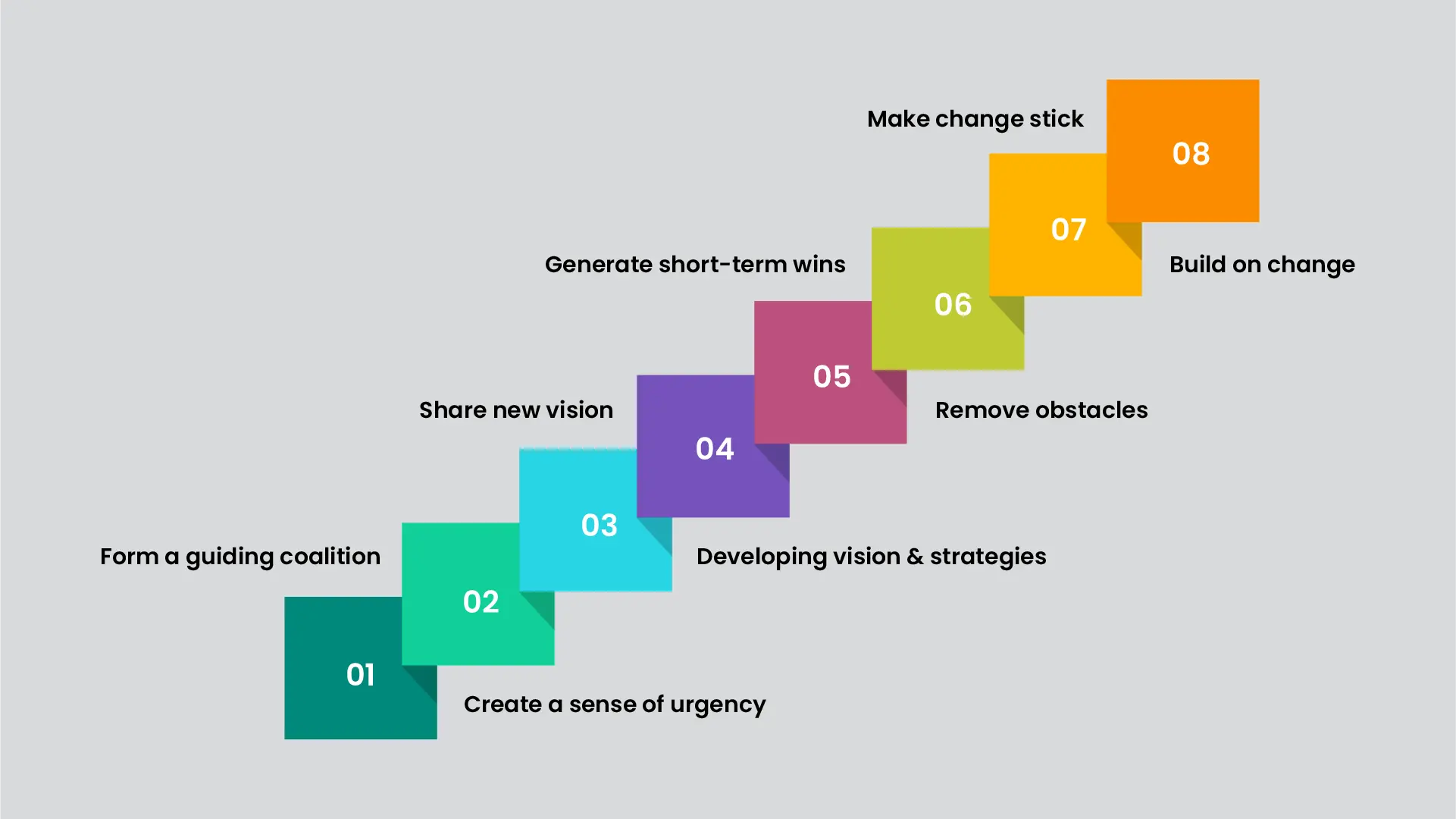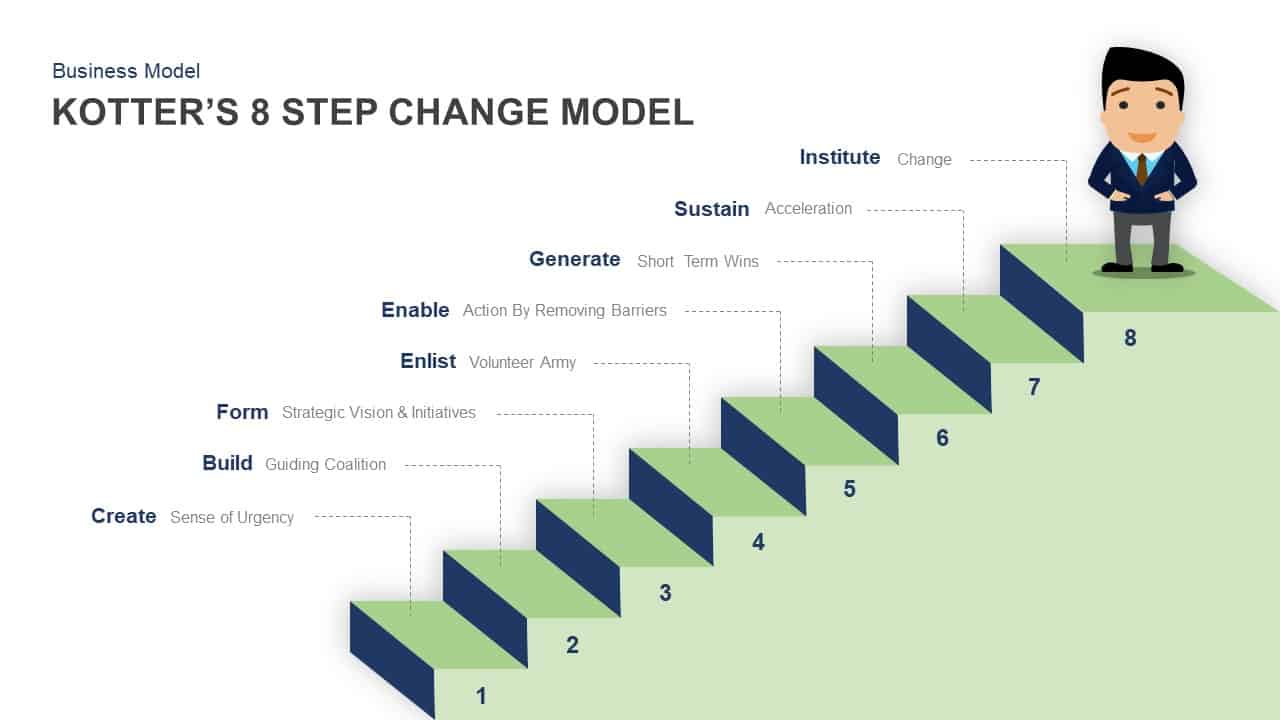Kotter’s 8 Step Change Model

As we all know change is inevitable to get desired goals. However, adapt to change is not an easy task. Both professional and personal life demands changes to be adopted. At this challenging time, organizations need changes from their traditional ways of operations and should adopt new methodologies and strategies to stay on the market.
If you want to successfully implement change, you should have a proper change framework. Here, the importance of Kotter’s change management has come into play. Kotter’s 8 step change model shows how to implement systematic plans and strategies for organizations systematically.
Kotter’s 8 step change model
John Kotter, change management professor and research expert on leadership matters at Harvard Business School, familiarized his popular 8-Step Change Model in his 1995 book, “Leading Change”. Built on the work of Kurt Lewin, the model sets out the 8 key steps of the changes process, arguing that ignoring any of the steps can be enough for the whole effort to fail. He strongly believes that when organizations placing changes in operations there is only a 30% chance of successful implementation. Kotter states change can come as mergers, new technologies, new strategies, acquisitions, cultural transformations etc.
Employing change isn’t always easy. Obstacles can come in various forms; lack of workplace cultures, teamwork or leadership, rigid and arrogant attitudes, general human fear, etc. can disrupt any change implementation project. And there is a natural tendency to unfollow change is a strong impulse in public.
The eight-step change model of John Kotter highlights organizations should follow to overcome such threats and challenges and put large-scale change into effect successfully. Following these steps will ensure that at the end of the process, the organization will not only be prepared but also be dedicated to coping with the changes.

-
create a sense of urgency
Everyone in an organization should realize the need for change. The process should begin with creating a sense of urgency among both managers and workers. Everyone involved should feel the need for change or that change is inevitable for organizational development. Without their support, it will make it hard to keep the drive of the change initiative and achieve long-lasting transformation.
Normally, when the system fails to satisfy needs people automatically embracing changes. But people don’t feel such problems, and then there is an urgency to create sense deliberately.
The aim of this step should be to prepare the workers for the impending change and motivate them to offer their input.
So, organizations managerial staff and departments should support the change initiatives in order to tune a sense of urgency from employees.
- Conducting a SWOT analysis with team members may help management portraying what could happen in the future.
- Frankly discuss with staff members about what is happening and why change is necessary at this time.
- Form an executive panel to talk about the challenging issues, and the possible solutions.
- Ensure support from stakeholders on change matters.
-
Form a Guiding Coalition
It will be very tough to lead the whole change process on your own, and therefore it is important to form a coalition to help you direct others. The second step is committed to bringing together a capable team with the right skills, qualifications, reputation, connections and necessary power to provide leadership to the change efforts and influence stakeholders.
The team will be responsible for developing the vision and strategies, providing the resources, eliminating barriers, guiding the organization during the process, resolving conflicts and interacting with the stakeholders. An effective team should
- Have a collective understanding of the need for change
- Have a common understanding of the job and purpose of the team, as well as the goals and aims it’s trying to attain
- Have a perfect idea about the roles and responsibilities of each other as well as the performance measures
- Know the risks and challenges related to the change initiative and the success factors
- Have clear processes for determining success, decision-making, tracking issues, and resolving conflicts
- Have clear communications channels
-
developing vision and strategies
The guiding coalition and leadership now should synchronize to create an inspiring vision for change within the organization. By framing this clear vision, everyone throughout the organization can understand fully what the project is pointing to achieve within the defined timeframe. It helps create a picture of what the future of the organization looks like once the change is applied.
The right vision aids accomplish change successfully by inspiring and guiding team performance and decisions. Vision will help to achieve the target and measure the efforts to put and the stakeholder’s attitude towards change.
To set a clear vision,
- Synchronize vision with values essential to the organization and the change initiative
- Discuss with employees when developing the vision
- Make sure that it can be transferred easily and is easy to comprehend by everyone
- Integrate data such as predictions, market research data, business trends, etc.
- Confirm that it is simple enough to be explained in five minutes or less

download Kotter’s 8 step change model in PowerPoint & keynote
-
share new vision
Crafting the vision is not enough to make support for it; it then needs to be communicated throughout the business. This is an outstanding opportunity to utilize the coalition you have built up, as between them they are likely to have linkages in every area of the business
The objective here is to conjure the hearts and minds of the employees; to get them to make ready to support the change, to get them to have faith in that change is possible and the follow-on benefits are for the best of the organization as well as themselves.
To do this commendably,
- Communicate the vision and strategies as regularly as you can by combining them in the daily decision-making, problem-solving and actions
- Walk the talk. It’s significant that the senior management exhibit the ideal behaviour that they expect from the rest of the employees
- Encourage feedback from workers and address their worries, problems, annoyance, and concerns openly and fairly
- Use simple words when sharing the message to avoid confusion and doubt
- Make use of all the organizational communication channels to get the word out.
-
Remove obstacles
The first four steps are necessary for framing the strength of your change initiative. But it is also vital to look for what is likely to lessen its chances for success. Whether its persons, traditions, regulations, legislations or physical obstacles. When implementing process changes, obstacles may occur recurrently.
Blockades may come in the form of inadequate processes, hesitations by employees to adapt to change, disempowering managers, administrative policies and their structure, etc.
In this phase, the guiding coalition and the high-ranking management should focus on removing such problems that block the organization’s path to achieving the change vision.
- Unmistakably understand the blockades within the organization that are hindering the implementation of change. The guiding coalition that consists of workers with different know-how can help in this step. And openly communicating with staff and stakeholders can also help identify the blockades.
- Ensure that organizational practices, structures, procedures, reward systems, etc. are affiliated with the new change vision.
- Identify and reward employees that actively work on executing change
- Enable employees to do their best and face challenges successfully by giving them the essential training, tutoring and mentoring.

image source; slidebazaar.com
-
Generate short-term wins
Success is the best master than motivation. So, try to create short-term wins by the newly implemented strategies. To keep the impetus going and to inspire employees to keep backing the initiative, it’s vital to have short-term goals to achieve and celebrate early in the change process.
A short-term win is an organizational upgrade that can be applied within a short period of time. Such a quick win should be visible throughout the organization, explicit, and linked to the change initiative.
- Identify achievable short-term wins; for example, this could include efforts that may help cut back costs, improve methods, increase profit, etc. It’s important to methodically consider the pros and cons of the target you select as worsening an early goal may depress the team.
- Break down the change project into minor parts with short-term goals
- Recognize and reward those who are responsible for these quick wins to encourage other workers as well
-
build on change
This stair is all about nourishing the implementation of change by warranting that the teams are working determinedly towards achieving the change vision while measuring progress. It’s imperative to make sure that the team doesn’t declare triumph impulsively after a few quick wins.
To continue the momentum of change,
- After every win, pinpoint what worked and what went wrong to decide what needs to be upgraded
- Unite the gains from the quick wins and continue to work on applying larger change throughout the organization
- Classify and do away with unnecessary processes and inter-dependencies
- Share the new vision and its benefits across the organization
-
make change stick
Anchor the changes in corporate culture. in this step, the change leaders work on fostering a new culture where change can pole. This contains changing organizational standards and values, methods, reward systems, and other infrastructure features to make sure that everything aligns with the new direction.
To effectively implement change,
- Talk over the importance of the new changes by pointing out the benefits they bring
- Find and incorporate norms and values that strengthen the change
- Integrate these new norms and standards when selecting and contracting new talent, promoting employees, etc.
- Make new teaching, training and development programs to help workers develop skills and abilities pertinent to the new changes
- Improve or remove organizational processes that do not make a parallel with the new culture. Also, remove individuals who are obstructing progress.
Final word
The main reason that Kotter shapes these steps is to highlight that change is not a simple and quick process. Many steps of planning are essential and even when the change has been implemented there is still a lot to do to ensure it is productive. Kotter claims that 70% of change initiatives be unsuccessful, and attributes this to the fact that most organizations do not put in the required preparation or understand the project properly. if you can follow these steps, it will ensure your change initiative is more likely to be a long-term victory.

